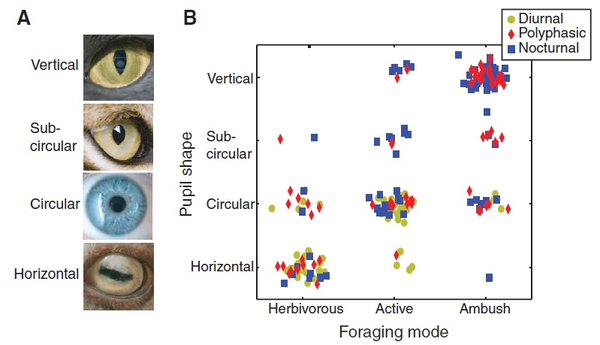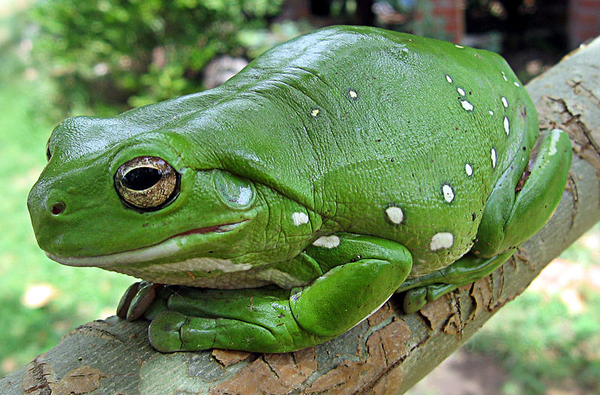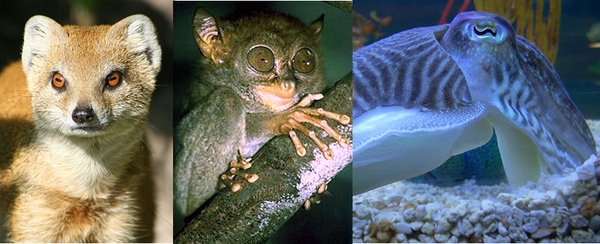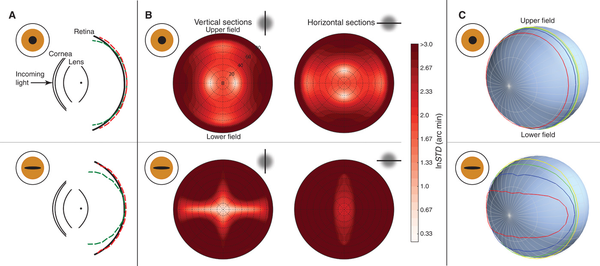羊的瞳孔為什么是長方形的?

 釀造現場Z-BO,化學博士 半導體行業資深廚師 釀造現場BrewSpot
釀造現場Z-BO,化學博士 半導體行業資深廚師 釀造現場BrewSpot
原本是想找謎底,可是發現知乎這個問題真的很老了,可能有些工具沒有更新。可是我找到了一篇研究來歷于一篇 2015 頒發在《Science Advances》上的文章(頂刊子刊,IF=11.57),我認為說服力比力強。這里是原文 PDF 鏈接:
果殼的這篇文章對這個研究做了一部門的闡釋:
為什么動物的瞳孔有分歧外形科學人果殼科技有意思
這里面提到了瞳孔外形和動物覓食體例的關系。簡單歸納綜合,瞳孔外形大致分為四種:橫瞳(山羊),圓形(智人,猩猩),近圓(某些鳥類),豎瞳(某些蛇)。還有最終捕食者的變形瞳孔(沒錯,就是貓)...這些瞳孔和這些動物的覓食體例呈現了一個大要的正相關。對角線上的關系仍是比力較著的。

草食性動物(herbivorous)大多是橫瞳,也有一部門是圓瞳。
這些動物的眼睛大多長在頭部兩側,很是寬的單眼視野可以幫忙它們盡量削減視覺盲區。與豎瞳相反,橫瞳會增添物體在橫標的目的上的景深,同時讓前方和后方的地面當作像更清楚。對于被捕食的動物來說,橫瞳既能幫忙它們擁有清楚的橫標的目的全景視覺,以探測來自分歧偏向的捕食者,同時又能讓它們在眼睛長在兩側的環境下,也能看清前方地面的環境,在遭遇捕食者追趕時,可以或許看準地形快速逃跑。
而瞳孔外形接近豎條型的話,就能對景深有更好的把握。

所以像蛇和貓這類伏擊捕食(ambush)動物,他們需要包管一擊必中的捕食體例,所以對于獵物所處的位置要有更好的把握。(所以逗貓的話,要上下揮舞逗貓棒啊!!!)
我感覺這個謎底是比力可以或許令人信服地詮釋了為什么羊的瞳孔是橫標的目的的。
可是,橫標的目的瞳孔也紛歧心猿意馬是長方形的!也可以像有些青蛙一樣,是橫紡錘形的。

事實上,橫瞳的動物不止是山羊,下面的幾種動物也都是橫瞳。

仍是上面的那個 Science Advances 的研究申明,橫瞳可以或許改釀成像。而長方形的瞳孔對于當作像起到的感化是對像投射到視網膜上的外形發生影響。

Pupil shape and image quality in the model sheep eye.
(A) Schematic sheep eyes viewed from above. The upper plot is for a circular pupil and the lower plot for a horizontally elongated pupil with the same area. The black curves represent, from left to right, the anterior and posterior surfaces of the cornea (radius 11.66 and 13 mm, thickness 0.8 mm, refractive index 1.382), the anterior and posterior surfaces of the lens (radius 9.17 and ?8.12 mm, thickness 9 mm, refractive index 1.516), and the retina (radius 12 mm). The red and green dashed curves respectively represent the focal surfaces for vertical and horizontal contours. (B) Widths of sections through the point spread functions (PSF) for different pupils and retinal positions. The upper and lower plots were computed with circular (2.8 × 2.8 mm) and horizontally elongated (8 × 1 mm) pupils, respectively. The optic axis is in the center of each circular plot. Black concentric dashed circles represent different eccentricities. Colors correspond to the SD of the PSF (a measure of the spread of the PSF cross section) for vertical (left) and horizontal cross sections (right); lighter red corresponds to the smallest SD (that is, the sharpest image) and darker red corresponds to the largest SD (least sharp image). (C) Throughput for circular and horizontal pupils. The contour lines represent regions of constant throughput: red, blue, green, and yellow for 80, 60, 40, and 20%, respectively.
這里我對這個圖做一些稍微具體一點的詮釋:
- 圖 A 顯示的是圓瞳和橫瞳的在視網膜上。紅色曲線和綠色曲線別離代表了縱標的目的和橫標的目的聚焦面。(紅色=縱標的目的,綠色=橫標的目的)。
- 圖 B 中顯示的橫瞳和豎瞳對于橫標的目的和縱標的目的光線刺激,在視網膜上對應的反映。圖中紅色越亮,暗示當作像越清洗;紅色越暗,暗示當作像越不清楚。
- 圖 C 顯示的是圓瞳和橫瞳對光線的經由過程率。紅色代表 80%光線可以或許經由過程,藍色為 60%,綠色為 40%,黃色為 20%。
我感覺這個圖是全文里最有效的圖了。不僅直接顯示了橫瞳對于當作像的影響,也申明了橫瞳可以或許包管動物在程度偏向上在更廣的角度看得更清楚。事實上,有科學家研究表白,綿羊具有大約 270-320 度的寬視角,而山羊的視野規模在 320-340 度之間(人類的視野規模在 160-210 度之間)。【1,2】高下立判!這個級此外橫標的目的視野根基是全景視野了,稍微轉回頭就能看到方圓的一切。固然聚焦能力有限,可是只要可以或許發現捕獵者呈現,他們可以或許逃命就好。
這個是文章的 supporting information,這個不需要權限就能看。Table S1就是所有動物的瞳孔外形和名字的表格,很全。有前提的同窗們想看的話,可以點下面這個鏈接。
References:
- Chuan-Chin Chiao, Misha Vorobyev, Thomas W. Cronin, Daniel Osorio, Spectral tuning of dichromats to natural scenes, Vision Research, Volume 40, Issue 23, January 2000, Pages 3257-3271, ISSN 0042-6989, 10.1016/S0042-6989(00)00156-5.(: Spectral tuning; Natural scene; Color vision; Dichromacy; Visual ecology
- Judith K Blackshaw. Accessed 11/23/11;
- 發表于 2019-06-17 23:05
- 閱讀 ( 2345 )
- 分類:其他類型
你可能感興趣的文章
- 葡萄干的功效作用 830 瀏覽
- 紅豆的功效和作用 796 瀏覽
- 發生酒精中毒該如何急救 841 瀏覽
- 臉上疙瘩怎么消除 765 瀏覽
- 發生食物中毒該如何急救 817 瀏覽
- 百香果的功效作用 826 瀏覽
- 最傷胃的幾種行為 759 瀏覽
- 蓮霧的功效和作用 822 瀏覽
- 牙痛該怎么辦---你知道嗎 706 瀏覽
- 烏梅的功效和作用 1168 瀏覽
- 山楂的功效和作用 696 瀏覽
- 牙疼的注意事項須知 785 瀏覽
- 豆腐的功效和作用 936 瀏覽
- 銀杏茶的作用與制作方法 715 瀏覽
- 西瓜的功效作用 774 瀏覽
- 又到大學畢業季,年輕人待價而沽? 708 瀏覽
- 支柱產業崩塌,“天佑南非”的黃金產量已經這么少了? 928 瀏覽
- 48歲女快遞員被迫下跪:以德報怨,何以報德? 954 瀏覽
- “食物相克”的說法是真的嗎? 675 瀏覽
- 我們為什么會對不起河北? 773 瀏覽
- 為什么地球上只有人類進化成智慧物種? 981 瀏覽
- 羅馬腳、希臘腳、埃及腳…你是哪種腳? 1261 瀏覽
- 肉毒桿菌:從致命毒藥到“整容良方”? 856 瀏覽
- 2019年美洲杯參賽球隊 分組情況 小組晉級賽制 821 瀏覽
- 2019年NBA猛龍隊獲得總冠軍分析 998 瀏覽
- 日本瘦腰鍛煉法:瘦肚子5個動作15天逆襲小蠻腰 686 瀏覽
- 3Dmax如何制作發光石 843 瀏覽
- Apowersoft 錄音如何錄制.wav格式聲音 775 瀏覽
- 如何把Excel中一列內容變成一行 1867 瀏覽
- Word2010如何制作請柬 940 瀏覽
相關問題
0 條評論
0 篇文章
作家榜 ?
-
 xiaonan123
189 文章
xiaonan123
189 文章
-
 湯依妹兒
97 文章
湯依妹兒
97 文章
-
 luogf229
46 文章
luogf229
46 文章
-
 jy02406749
45 文章
jy02406749
45 文章
-
 小凡
34 文章
小凡
34 文章
-
 Daisy萌
32 文章
Daisy萌
32 文章
-
 我的QQ3117863681
24 文章
我的QQ3117863681
24 文章
-
 華志健
23 文章
華志健
23 文章
推薦文章
- 一起來捉妖許愿星覺醒進化哪個妖靈厲害
- 明日方舟突襲2
- 明日方舟突襲1
- LOLS9英雄聯盟9.12版本新版鐵男鐵鎧冥魂出裝
- 不敗的意志幻化外觀獲取方法
- 決戰奧格瑞瑪單刷攻略
- 密室逃脫9—第6關攻略
- 魔古山寶庫皇帝意志如何進入戰斗
- 媽媽把我的游戲藏起來了2手游攻略第十五關
- 我與兄貴下電梯的二三事第2
- 遇見逆水寒如何穿越到現代
- 天龍八部的存放背包怎么使用它們
- 守護冰塊第25關通關秘籍
- 我的世界最簡單紅石電梯制作方法
- 夢想城鎮怎么邀請好友
- COC部落沖突
- 變形金剛地球之戰如何獲得榮耀之戰稱號
- 迷你世界摩天輪怎么做 迷你世界摩天輪怎么轉
- 王者榮耀s16賽季將要上線的新皮膚匯總
- 我的世界鐵傀儡怎么做 我的世界鐵傀儡出現條件
- lol英雄聯盟9.11版本庫奇如何出裝符文推薦
- 我的世界地圖怎么做?地圖有什么用
- lol英雄聯盟9.11版本約里克如何出裝符文推薦
- 我的世界怎么徹底銷毀物品
- lol英雄聯盟9.11版本奧拉夫如何出裝符文推薦
- dnf夜之摩天樓怎么進去
- 分享和平精英透視2019最新教程
- 和平精英怎么使用地圖和平精英怎么標記自身位置
- 扭蛋販賣屋禮品機怎么玩
- 明日方舟1